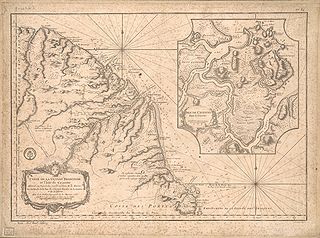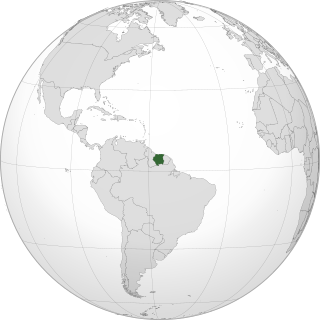
The history of French Guiana dates back to the period prior to European colonization. Prior to the arrival of the first Europeans, there was no written history in the territory. It was originally inhabited by a number of Native American peoples, among them the Kalina (Caribs), Arawak, Galibi, Palikur, Teko, Wayampi, and Wayana. The first Europeans arrived in the expeditions of Christopher Columbus, shortly before 1500.

Dutch colonisation of the Guianas —the coastal region between the Orinoco and Amazon rivers in South America—began in the late 16th century. The Dutch originally claimed all of Guiana but—following attempts to sell it first to Bavaria and then to Hanau and the loss of sections to Portugal, Britain, and France—the section actually settled and controlled by the Netherlands became known as Dutch Guiana.

Equinoctial France was the contemporary name given to the colonization efforts of France in the 17th century in South America, around the line of Equator, before "tropical" had fully gained its modern meaning: Equinoctial means in Latin "of equal nights", i.e., on the Equator, where the duration of days and nights is nearly the same year round. The settlement was made in what is now known as the Bay of São Luis and lasted for 3 years.

The Curonian colonization of the Americas was performed by the Duchy of Courland, which was the second-smallest state to colonise the Americas, after the Knights of Malta. It had a colony on the island of Tobago from 1654 to 1659 and intermittently from 1660 to 1689.

Joseph-Antoine le Fèbvre, sieur de La Barre was a French lawyer and administrator best known for his disastrous three years as governor of the colony of New France (Quebec).

The Guianas, sometimes called by the Spanish loan-word Guayanas, is a region in north-eastern South America which includes the following three territories:

The Pomeroon River is located in Guyana, South America, situated between the Orinoco and the Essequibo rivers. The area has long been inhabited by Lokono people. The Pomeroon River is also one of the deepest rivers in Guyana.
David Cohen Nassy was a professional colonizer who started Jewish colonies in the Caribbean. He had several nicknames: Cristovão de Távora and José Nunes da Fonseca.
Oyapoc was a short-lived English settlement in French Guiana on the Oyapock river. Charles Leigh had visited the area in 1602, and considered it suitable for a colony. On returning, he assembled a crew of 46 people and embarked on the Olive Plant. The settlers planned to look for gold in the area. They set sail on 21 March 1604, and arrived in Oyapoc on 22 May 1604 taking possession of the country "in the eyes of the Indians." Leigh gave the name Caroleigh River to the Wiapoco. He dubbed the settlement Oliveleighe, and the principal site for settlement was called Principium or Mount Howard. The Olive Plant was sent back, and thirty-five men and boys remained at the settlement. Upon begging his brother, Sir Oleph, for reinforcements, The Olive Plant returned, renamed The Phoenix, to find the settlement in "a rather critical position." The settlers experienced mutiny, and a raid by Caribs from the Cayenne River. On 31 May 1606, the remaining settlers left on the Hope.

Jodensavanne was a Jewish plantation community in Suriname, South America, and was for a time the centre of Jewish life in the colony. It was established in the 1600s by Sephardi Jews and became more developed and wealthy after a group of Jews fleeing persecution in Brazil settled there in the 1660s. It was located in what is now Para District, about 50 km (31 mi) south of the capital Paramaribo, on the Suriname River. Sugarcane plantations were established and Black African people were used as slave labour. At its height in around 1700 it was home to roughly 500 plantation owners and 9000 slaves. The colony faced regular attacks from Indigenous people, slave revolts, and even raids from the French navy. The community eventually relocated to the capital of Paramaribo. Clearing of grave sites and maintenance of the synagogue ruins has been attempted at various times from the 1940s to the 21st century.
Jan van Ryen was a 17th-century Dutch privateer, explorer, and colonist. He was granted a commission by the Dutch West Indies Company and active against the Spanish in the West Indies during the 1620s. He and Claude Prevost attempted to establish Dutch colonies in Guyana, although they both failed with most Dutch colonists being killed by natives in 1627. However, Zeelandian merchant Abraham van Peere was able to found a successful colony in the area shortly after.
The Cassard expedition was a sea voyage by French Navy captain Jacques Cassard in 1712, during the War of the Spanish Succession. Targeting English, Dutch, and Portuguese possessions, he raided and ransomed the colonies of Cape Verde, Sint Eustatius, and Curaçao—factories, depots, and seasoning camps used in the Atlantic slave trade. He also raided and ransomed Montserrat, Antigua, Surinam, Berbice, and Essequibo—wealthy sugar-producing colonies in the Caribbean whose economies were based on the exploitation of slave labor.

Pomeroon is the name of a former Dutch plantation colony on the Pomeroon River in the Guyana region on the north coast of South America. After early colonization attempts in the late 16th century were attacked by Spaniards and local Indians, the original inhabitants fled the interior of Guyana, founding the colony of Essequibo around Fort Kyk-Over-Al shortly after. A second, and more serious attempt at colonization started in 1650, but was ultimately unsuccessful, as French privateers destroyed the colony in 1689. In the late 18th century, a third attempt of colonization was started, this time under the jurisdiction of the Essequibo colony.

Surinam, also unofficially known as Dutch Guiana, was a Dutch plantation colony in the Guianas, bordered by the equally Dutch colony of Berbice to the west, and the French colony of Cayenne to the east. It later bordered British Guiana from 1831 to 1966.

The history of the Jews in Suriname starts in 1639, as the English government allowed Spanish and Portuguese Jews from the Netherlands, Portugal and Italy to settle the region, coming to the old capital Torarica.

The history of the Jews in Guyana goes as far back as the 1600s. Representation has always been low, and by the 1930s there was neither an organized Jewish community nor a synagogue in the capital city of Georgetown. In the late 19th and early 20th centuries, several Jewish families immigrated to British Guiana from Arab lands to avoid persecution and expand business opportunities.

Surinam, also known as Willoughbyland, was a short-lived early English colony in South America in what is now Suriname. It was founded in 1650 by Lord Willoughby when he was the Royalist Governor of Barbados.

Fort Cépérou was a fort that protected the city of Cayenne, French Guiana. It is named after Cépérou, a celebrated indigenous chief who ceded the land.
Daniel Guerin Spranger, or Quijrijn Spranger, Gerrit Spranger was a Dutch Jewish entrepreneur who was the commander of the colony of Cayenne, now in French Guiana, between 1656 and 1664. The island of Cayenne had earlier been abandoned by the French. Spranger established good relations with the indigenous people and founded plantations of sugarcane and other tropical plants. In 1664 the French returned in force, and Spranger ceded the colony on the best terms he could get. In 1676 the Dutch again captured Cayenne, and later that year the French again regained control. Spranger seems to have been among the Dutch prisoners shipped back to France in 1676.

The Compagnie de la France équinoxiale, or Compagnie de l'establissement des colonies françoises dans les terres fermes de l'Amerique, was a French enterprise formed in 1651 to colonize equatorial South America. The enterprise soon failed. In 1663 it was relaunched, but the next year was merged into a general company for all French possessions in the Americas. The colony of Cayenne, the nucleus of French Guiana, was eventually secured in 1674.















